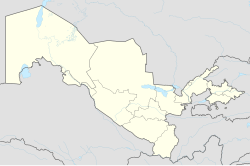
Back منارة كاليان Arabic Kalyan minarəsi Azerbaijani Кәлән манараһы Bashkir Kalon-Minarett German Minarete de Kalyan Spanish مناره کلان Persian Minaret Kalon French कल्याण मीनार Hindi Nagy minaret (Buhara) Hungarian Minaret Kalyan ID
 The Kalyan Minaret in 2003 | |
| Alternative name | Minâra-i Kalân, Kalon Minor, Poi-Kalyan Minaret[1] |
|---|---|
| Location | Bukhara, Uzbekistan |
| Region | Bukhara Region |
| Coordinates | 39°46′33″N 64°24′51″E / 39.77583°N 64.41417°E |
| Type | Monument, Minaret |
| Part of | Po-i-Kalyan mosque complex |
| Width | Diameter 9 m bottom, 6 m top |
| Height | 45.6 m (150 ft), Tip 48 m |
| History | |
| Builder | Arslan Khan Muhammad, Kara-Khanid Khanate |
| Material | Bricks |
| Founded | 1127 AD |
| Periods | Western Karakhanid dynasty |
| Cultures | Islamic |
| Official name | Historic Centre of Bukhara |
| Type | Cultural |
| Criteria | (ii)(iv)(vi) |
| Designated | 1993 (29th session) |
| Reference no. | 602 |
| Bukhara region | List of World Heritage Sites in Northern and Central Asia |
The Kalyan Minaret (Uzbek: Minorai Kalon, Persian/Tajik: Minâra-i Kalân, Kalon Minor, Kalon Minaret[2]) is a minaret of the Po-i-Kalyan mosque complex in Bukhara, Uzbekistan and one of the most prominent landmarks in the city.
The minaret, designed by Bako, was built on an earlier existing structure called Kalyan by the Qarakhanid ruler Mohammad Arslan Khan in 1127 to summon Muslims to prayer five times a day. An earlier tower was collapsed before starting this structure which was called Kalyan, meaning welfare, indicating a Buddhist or zoroasterian past. It is made in the form of a circular-pillar baked brick tower, narrowing upwards. It is 45.6 metres (150 feet) high (48 metres including the point), of 9 metres (30 feet) diameter at the bottom and 6 metres (20 feet) overhead.
There is a brick spiral staircase that twists up inside around the pillar to the rotunda. The tower base has narrow ornamental strings belted across it made of bricks which are placed in both straight or diagonal fashion.[3] The frieze is covered with a blue glaze with inscriptions.
In times of war, warriors used the minaret as a watchtower to lookout for enemies.[4]

About a hundred years after its construction, the tower so impressed Genghis Khan that he ordered it to be spared when all around was destroyed by his men.[5] It is also known as the Tower of Death, because until as recently as the early twentieth century criminals were executed by being thrown from the top. Fitzroy Maclean, who made a surreptitious visit to the city in 1938, says in his memoir Eastern Approaches, "For centuries before 1870, and again in the troubled years between 1917 and 1920, men were cast down to their death from the delicately ornamented gallery which crowns it."[6]
- ^ "Historic Centre of Bukhara". unesco.org. Retrieved 20 September 2018.
- ^ "Kalon Minaret". lonelyplanet.com. Retrieved 20 September 2018.
- ^ www.advantour.com/uzbekistan
- ^ Michell, G. 1995. Architecture of the Islamic World. London: Thames and Hudson, 259
- ^ Mayhew, Bradley; Clammer, Paul; Kohn, Michael D. Lonely Planet Central Asia. Lonely Planet Publications. ISBN 1-86450-296-7.
- ^ Maclean, Fitzroy (1949). "X: Bokhara the Noble". Eastern Approaches. Jonathan Cape. p. 147.
